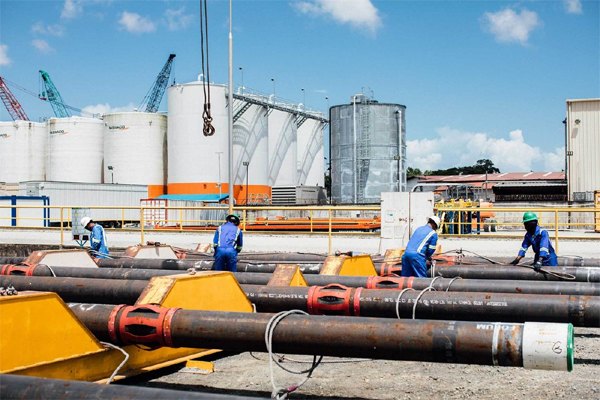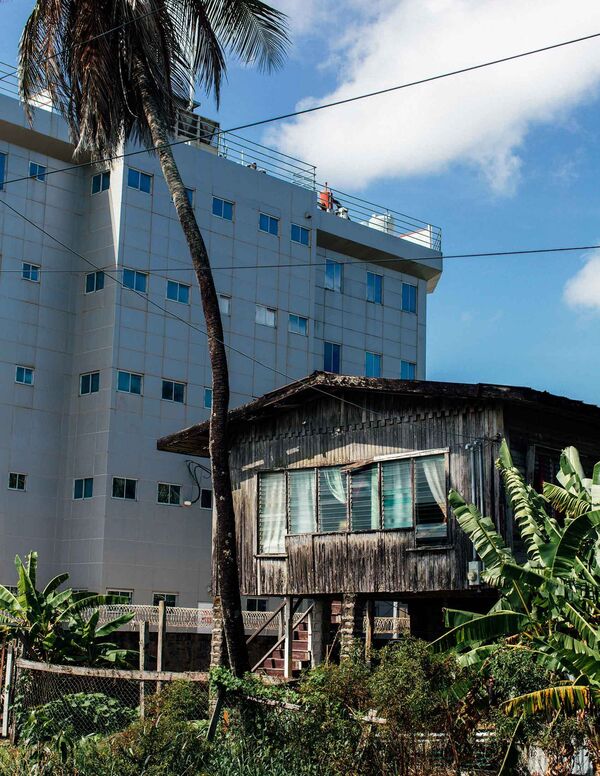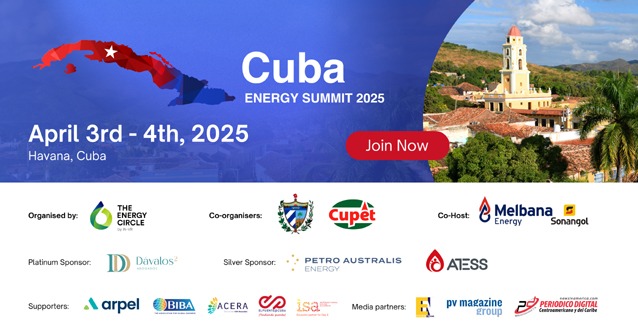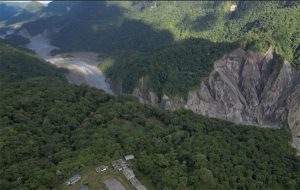As rising seas imperil Guyana, leaders sign sweetheart deals with Exxon to help fund the transition to a sustainable future.

Monte Reel, Businessweek
GEORGETOWN
Energiesnet.com 11 21 2022
Go to the seawall in Georgetown late on a Sunday afternoon, and you’ll find Guyana with its guard down. Everyone’s “liming”—a term that washed onto this South American shore decades ago from Trinidad that means hanging out, talking about nothing. To lime isn’t to deny the existence of challenges or threats, it’s to temporarily deny them the power to darken your state of mind.

Families sit side by side on the waist-high concrete wall, feet dangling, the sea breathing hard behind their backs. Across the shoreline road, vendors under nylon canopies sell fried fish and plantain chips. Just after the sun sinks into the water, the rear doors of minivans swing open, speakers pulsing with reggae and hip-hop. Every now and then, the sea asserts itself, slamming against the wall, spraying a salty mist. Less often, maybe a couple times a year, it sends waves all the way to the road. On very rare occasions—like that unforgettable January back in 2005—tides and rain conspire to swallow the seawall whole, deluge nearby homes and carry off some of the people there.

Theoretically, every one of Guyana’s 800,000 or so residents could claim for themselves about 66 acres of real estate inland, safe from the sea. Much of that land is forested, some of it full of rare wonders, like endangered polychromatic tree frogs and waterfalls spilling from green plateaus. In reality, roughly 90% of the population is crammed into the narrow floodplain hugging the Caribbean. Almost half of them live in Georgetown, the waterlogged capital, most of which sprawls across a coastal basin that’s about 7 feet below sea level and depends on a network of drainage canals to remain habitable.
They live on the coast because that’s where the economic opportunities, such as they are, can be found. Guyana historically has been one of the poorest countries in the Western Hemisphere; from 2000 to 2015 the gross domestic product of the entire country was much smaller than that of most midsize US cities.

Such modest fortunes could be swept away in an instant. That 2005 tidal surge wiped out 59% of the annual GDP. Putting in adequate countermeasures—expanding and reinforcing the 280-mile long seawall, upgrading drainage canals, building housing infrastructure on higher ground—will cost billions.
Guyana will almost certainly experience another devastating surge. Warming Caribbean waters are projected to rise 8 to 10 inches in the next 30 years, according to the U.S. National Ocean Service. And if the world continues to burn fossil fuels at the going rate, the same report says the sea will rise 6 feet by century’s end. If nothing else changes, Georgetown’s seawall will be under water, and its residents will have scattered.
In the face of this, Guyana’s government is betting on a paradox: The very thing that threatens the country will be its salvation. The country’s leaders, praised in the past for their environmental stewardship, now believe the most effective way to rescue Guyana from fossil-fuel-induced climate change is—crazy as it sounds—to fully embrace the business of fossil fuels.
At the bottom of Guyana’s share of the Caribbean Sea sits a massive cache of oil. In 2015 exploration crews from Exxon Mobil Corp. found what would prove to be billions of barrels of crude about 120 miles from the shore—a once-in-a-generation jackpot that accounts for about one-third of the total oil discoveries worldwide since then. Some industry analysts estimate that the reserves in Guyanese waters could equal China’s.
The collision of these elements—the tangible threat of climate change, the country’s extreme economic stress and the sheer enormity of the discovery—has turned this strip of South American coastline into something of a proving ground, the spot on the map where the contemporary tensions shaping the world’s energy landscape have most forcefully converged. Other countries have stumbled upon truly transformational oil finds, but none has done so under circumstances quite so stark, at a moment long after the developing nations of the world pledged to wean themselves off of fossil fuels.
“Investing in new fossil fuels is moral and economic madness,” United Nations Secretary-General António Guterres declared earlier this year. Maybe so, but for Guyana’s leaders to reject a discovery potentially worth hundreds of billions of dollars would be political madness.

They’ve promised to create a different kind of petrostate: an environmentally sustainable one that uses oil revenue to build a more durable infrastructure powered by renewable energy. Other developing countries with potential oil reserves are watching Guyana: They, too, want to know if drilling could be an acceptable way to pay for entry into a post-oil future.
Since the first oil was drilled three years ago, Guyana’s economy has become the fastest-growing in the world. And some of the new petrostate’s weaknesses are already being exposed. Its contract with Exxon gives the company unusual advantages: a bigger share of revenue than normal with fewer tax requirements. Even so, Guyana is exploiting as much of its oil as it can, as fast as it can. The oil is quickly flowing, the sea is slowly rising, and the world is watching.

On the morning of May 26, Guyana’s Independence Day, dozens of government-issued cars and trucks left the capital to venture west along the coast. Custom dictated that the president and other officials would celebrate the holiday during a midnight flag-raising ceremony.
They were heading toward Anna Regina, a town on the other side of the Demerara and Essequibo rivers. To cross the Demerara, the vehicles passed over a mile-long pontoon bridge that was meant to last 10 years when it was built 44 years ago. To cross the Essequibo, they boarded a ferry. The distance between Georgetown and Anna Regina, if you draw a straight line across the map, is about 40 miles. But the journey took more than three hours. The highest-ranking government officials flew.
At the ceremony in the town’s central square, President Irfaan Ali addressed the crowd with a State of the Union-style litany of triumph. He told them the pontoon bridge would finally be replaced with a permanent one. A four-lane highway was already under construction—one of dozens of road-building projects that will link Guyana’s cities to one another and to Brazil and Suriname. More homes than ever were being connected to reliable water and energy services, thanks to a 107% increase in the government’s capital budget this year alone. “We are finally on the path to prosperity,” Ali said.

Everyone knew the money for all of this was coming from oil. Guyana is producing about 360,000 barrels a day. That figure is expected to reach 580,000 next year, and likely 1 million a day by 2027. Guyana’s GDP is projected to jump 58.7% this year, and already oil accounts for more than 60% of the country’s exports, supplanting sugar and rice. It will expand the economy fivefold over 10 years.
Guyana’s blueprint for managing its growth is called the Low Carbon Development Strategy 2030. It aims to protect natural resources, mitigate climate change with reinforced seawalls and other infrastructural improvements and diversify Guyana’s industries. The oil money will fund a new energy grid that will eventually run exclusively on renewable sources. The document is based on a plan first floated during the presidency of Bharrat Jagdeo (1999-2011), who is currently serving as vice president, now updated to account for oil revenue. Term limits prevented Jagdeo from seeking reelection, but today he’s widely acknowledged, inside the government and among the public, as the man in charge of the country’s oil wealth.

Last year, Ali and Jagdeo pitched the oil-funded blueprint as an enlightened manifesto—a way for Guyana to break free from an oppressive global system that discriminates against developing countries. “Expecting developing economies to leave their oil in the ground really means protecting the monopoly-like situation of existing producers, so that they can maximize their income from oil and gas,” Ali said at the time. He called it a matter of economic justice. “No responsible government should volunteer that its people stay poor so that rich countries can have their market protected.”
Guyana might be setting a trend. Barbados Prime Minister Mia Mottley, who delivered the opening remarks at this year’s COP27 UN climate conference, recently reopened her country’s waters for exploration by fossil fuel companies. Her rationale echoed Guyana’s: Barbados hopes to use oil money to partly finance a complete shift to renewable fuels by 2030. It’s not an ideal solution, she suggested, but the developed nations of the world have given them little choice. Ever since the Kyoto Protocol was drafted in 1997, developed countries have pledged to contribute billions of dollars to poorer countries to help them adapt to climate change, which the industrialized world, primarily, triggered. Very little of that money has materialized.

So Ali, at the podium in Anna Regina, described the country’s recent growth as a leap toward true independence, 56 years after Guyana declared itself free from British rule.
About 20 minutes before the flag next to the stage was to be raised, the skies opened. Thousands of spectators scrambled for whatever cover they could find, but Ali and Jagdeo ventured out into the storm. They joined the flag-waving dance troupe that stomped in the puddles in front of a stage. Then, clothes soaked, glasses foggy, they returned to their VIP tent.
Rain fell all over the country that day and night. The next morning, Jagdeo toured a region where flooding had forced dozens of residents into an emergency shelter at a sports complex. “To manage Guyana is to manage water,” he said in an interview after he returned to Georgetown. And to do that, he suggested, Guyana was on its own. “If we wait on the world,” Jagdeo said, “we will be inundated by the sea.”
Guyana’s turn toward oil is awash in irony, not least because Jagdeo, as his presidency was ending in 2011, was lauded all over the world as an ecological superstar: the man who’d figured out how protecting the environment and limiting carbon emissions might supercharge, instead of strangle, financial growth in the developing world. At a gala in Seoul, he accepted a trophy as a “Champion of the Earth” from the UN. Five different universities, from Ontario to Moscow, awarded him honorary doctorates for his work to fight climate change. Time magazine printed his name on its cover as one of its “Heroes of the Environment.” In New York, the actor Harrison Ford and other environmental activists celebrated Jagdeo’s commitment to conservation. All praised him for coming up with a way for rich nations to reward poor ones that resisted the sort of development that drove up carbon emissions.
About 85% of Guyana remains covered in forest, sponging up tons of the carbon dioxide richer countries are emitting. Jagdeo argued Guyana should be compensated for the service. With the support of the UN, in 2009 he negotiated a deal in which Norway agreed to pay Guyana as much as $250 million to leave large swaths of its share of the Amazon rainforest untouched. In return, Norway would receive carbon credits to offset its overall emission totals, allowing it to meet its climate goals. It was the world’s first bilateral carbon-trading scheme.
Now, some of the organizations that heaped praise on Jagdeo seem conflicted about Guyana. For example, Conservation International’s local chapter last year rejected a $10 million grant to fund preservation and sustainable development initiatives because the money came from Exxon.
Jagdeo and Ali have responded to criticism by amplifying their insistence that Guyana can, in effect, have its cake and eat it too. “There’s absolutely no contradiction,” Ali said in an interview. “We are not moving away from any of our commitments. As a matter of fact, we are expanding our commitments on the side of the environment.” They believe today’s oil revenues can ensure that Guyana thrives even after the international demand for oil dries up. They figure they have about 30 years until that happens.
More than anything else, it’s this sense of haste—the desire to sign a contract and get the oil flowing with little regulatory interference—that has stoked the chorus of doubters. They’re armed with evidence from almost three years of drilling and analysis of a contract they say was flawed from the start. They believe the government’s plans have already begun to spin out of control.

In 2016, after the discovery was announced, Exxon and Guyana amended the original exploration deal they’d signed in 1999. The new contract, which split the oil revenue 50-50, with a 2% royalty paid to the government, struck industry analysts as an unusually sweet deal for Exxon. “It’s the most favorable I think I’ve ever seen in the industry, anywhere,” says Tom Mitro, a senior fellow at Columbia University’s Center on Sustainable Investment. As a financial officer at Chevron for three decades, Mitro crafted deals with governments in several developing nations. After that, he jumped to the other side of the table, consulting on behalf of developing countries, including Angola, in their dealings with fossil fuel companies.
Exxon defends the contract, saying that it took on significant risks by gambling on a country with no history of oil production and very little energy infrastructure. “The terms of our petroleum agreement with the government of Guyana are common in the industry and competitive with other countries at a similar stage of resource discovery,” a spokesperson for Exxon says.
But the terms with Guyana were drawn up after the discovery had been publicized as being unusually large. “Exxon makes the argument that they didn’t really know how much resource was there,” Mitro says. “Well, they did.”
A roughly even split isn’t unheard of for a high-risk operation with a shaky promise of payoff. When the probability of success is greater, the government generally gets a significantly larger share, often through increased royalties. According to Rystad Energy AS, an Oslo-based consultant, the global average for a government’s take in offshore projects is 75%.
Beyond the basic percentage splits, Mitro says even more surprising concessions are buried deeper in the contract. For example, the contract stipulates that any income taxes imposed on Exxon and its partners be paid for by the government. However, Guyana passes the companies a receipt for those taxes, which Exxon can use to earn a foreign tax credit in the U.S. Exxon says this is common practice. Mitro says that was once true, but now describes the practice as “highly unusual and beneficial to the companies.” An Exxon spokesperson notes that the company has spent $700 million with Guyanese businesses since 2015 and that half of its full-time employees in the country are Guyanese.
There are additional benefits to Exxon in the contract. The company is allowed to use current oil revenue to repay itself for future expenses for decommissioning and abandoning its wells. The company likely won’t incur those costs for decades. “I’ve never seen that, anywhere,” Mitro says.
The sheer geographic size of Exxon’s lease—26,806 square kilometers (10,350 square miles)—also matters. It’s about nine times larger than Exxon’s average international offshore lease, Mitro has calculated, and roughly 100 times larger than the average lease in the Gulf of Mexico. The Guyana contract includes an unusual provision allowing the company to immediately recover costs for additional exploratory work anywhere within that area. Exxon effectively pays itself back for those costs out of the oil that otherwise would go to the government. Most production-sharing agreements covering large areas allow such deductions only within small, specified areas, Mitro said, not everywhere under lease.

More than a year before drilling began, an adviser to then-President David Granger, Ali’s predecessor, raised warnings in public about many of these contractual concerns. The adviser’s own contract expired the next month and wasn’t renewed.
Today, Ali and Jagdeo acknowledge the contract does Guyana few favors. “The agreement could have been better,” Ali says, “but that’s water under the bridge.” They dismiss the idea of renegotiating and are instead focusing on crafting better future deals. In November, when the government announced plans to auction the leases to additional offshore exploration territories, Jagdeo promised that these contracts will correct some of the imbalances in the Exxon deal. Guyana will seek a royalty rate of 10% and will also impose a 10% corporate tax rate.
The man tasked with making sure that Exxon’s drilling operations would meet the country’s environmental standards was Vincent Adams, who’d spent his career monitoring the energy sector in the US. Adams was born in Guyana but worked for the US Department of Energy for 30 years. By the time he retired in 2016, he’d spent a decade with the Senior Executive Service, a DOE leadership team of the highest-ranking civilian professionals. “I thought I was done,” he says of his decision to retire. But after Exxon’s discovery, Guyana desperately needed seasoned advisers. “There just wasn’t anyone in Guyana with experience in that field,” Adams recalls. In 2018 he accepted the position of director of Guyana’s Environmental Protection Agency.
Both Exxon and Guyana’s government promised that the drilling operation itself would have an unusually small impact on the environment. When crude oil is drilled, the process produces waste in the form of natural gas, which is often disposed of by burning it off, or “flaring” it. Worldwide, gas flaring sends more than 400 million tons of CO₂ into the atmosphere each year. But the oil company assured the government that gas wouldn’t be flared at its rigs and would instead be reinjected into the ground. Guyana codified the promise, outlawing flaring in all phases of production—except during a rig’s initial startup, when minor, temporary flaring is practically unavoidable.

That promise has been broken, repeatedly. After the startup period, Exxon’s subsidiaries flared thousands of tons of gas, and they continued to do so throughout most of the first three years of production. The company blamed equipment failure—a faulty compressor that proved difficult to replace, it said. Exxon says that now, after the compressor has been fixed, its “Guyana operations are among the best performing in the world with regards to emissions intensity.”
Adams, tasked with holding the oil companies accountable, says he felt overwhelmed. “There was still nobody within the EPA with any training whatsoever—I mean zero training, not a single course in petroleum engineering—besides myself,” he says. That essentially left the oil companies in Guyana to regulate themselves, he says, and they took advantage of the situation by violating the no flaring policy on a daily basis. In the first 15 months of drilling, that flaring emitted about 770,000 metric tons of greenhouse gas emissions—more than the estimated annual emissions from all the passenger cars in Guyana.
Adams believed the government, including the administration of Ali and Jagdeo, which took over less than a year into the drilling, had surrendered far too much authority to Exxon and its partners. He argued that production levels should be drastically cut to reduce the flaring, a measure that he says Exxon fiercely resisted as it continued to blame the emissions on faulty equipment. “We know that they’re doing their best to try to fix it,” Adams told a reporter from Reuters in August 2020, “but the bottom line is it’s not fixed.”
Later that month, he was placed on administrative leave, and soon after that his contract was terminated outright. Adams says he lost his job for trying to hold Exxon accountable. The government didn’t comment directly on the dismissal of Adams, a member of an opposition political party, but suggested that such criticisms are politically motivated.
Shortly after Adams was fired, Guyana announced that instead of requiring Exxon to cut production to manage the flaring, it would fine the company $45 for each ton of carbon emitted. Ali has touted the measure as “one of the very few taxes on flaring in the world,” and he describes that levy, along with new restrictions on flaring, as an important environmental safeguard.
“It’s absolute nonsense,” Adams says from his home in Kentucky. According to his calculations, the fines allow the company to collect 30 times more revenue than it would if it reduced the flaring through production cuts. “Penalties are supposed to be a deterrent, but in this case, they’re an incentive,” Adams says.
Guyana hopes to capture the natural gas, which to date has been considered a waste product of the drilling process, and exploit it as a valuable resource. It plans to build a 120-mile pipeline to transport the gas to the shore, where it will be processed and used to power the energy grid.
In the meantime, a pending lawsuit brought by three individuals in Guyana argues that the flaring and other environmental violations have threatened the well-being of the country’s citizens. “My position is that you must comply with the laws of Guyana,” says Melinda Janki, the plaintiff’s lawyer. “If that means that the oil and the gas have to stay in the ground, that’s where they have to stay.”
Exxon’s contract, which split the oil revenue 50-50, with a 2% royalty paid to Guyana, struck industry analysts as an unusually sweet deal
When the Exxon contract was finalized in 2016, Guyana received a signing bonus of $18 million from the company, standard practice in the industry. But the government didn’t publicly acknowledge receiving those funds until it was leaked to the media, more than a year and a half later. Guyana’s constitution required such funds be deposited in an account administered by the Parliament. Instead, the bonus ended up in a government account that wasn’t subject to its oversight.
The former administration insisted it was all an innocent misunderstanding and said its internal auditing suggested that none of the funds had been improperly spent. The controversy eventually faded from front pages. But the secrecy surrounding the bonus reinforced a widely held belief in Guyana: The politicians tasked with managing the oil revenue can’t be trusted.
Graft in the public sector is simply assumed among much of the Guyanese public. In a 2022 national survey by the nonpartisan International Republican Institute, 57% of respondents said they believe the country’s natural resources sector, specifically, is plagued by “a lot” of corruption: 16% said they believe there is “some.” The fear is that Guyana will fall to the “resource curse”—a small group of well-connected elites will get extremely rich, while the rest of the population sees few benefits.

The mistrust is understandable, given that Guyana is, in fact, run by a small group of well-connected elites. The country’s demographics make that practically unavoidable. About 40% of its 800,000 citizens are mired in poverty, living on less than $5.50 a day. The average adult has had six years of schooling, and of those able to earn a college degree, an estimated 89% leave the country to work—the highest rate of brain drain in the world, according to the World Bank. Among the remaining workforce, only 2.3% have a bachelor’s degree, according to a 2018 study. The result is an extraordinarily tiny professional and political elite where the lines between familial and business relationships routinely blur.
The current administration established a sovereign wealth fund requiring all oil revenue to be publicly disclosed and placed into accounts that can be monitored by citizens; violations of the transparency requirements by officials come with a 10-year jail term. The government also became a member of the Extractive Industries Transparency Initiative, which requires member countries to publicly disclose information about how resource rights are awarded, track finances through public channels and report how those funds benefit the public.
Jagdeo has faced allegations of corruption since his first presidential term. Even as he was negotiating his carbon-trading deal, US officials warned in State Department cables that the international community should be wary of his tolerance for corruption in Guyana. Jagdeo denies any corruption.
Years later, after an opposing political party assumed the presidency in 2017, Jagdeo and other members of his cabinet were accused of fraudulently acquiring properties in a seaside housing development at prices far below market value. He was detained and questioned. After the 2020 elections, Ali and Jagdeo’s government dissolved the investigative unit conducting the inquiry into the housing deals. And late last year their attorney general announced his office was launching an investigation into the Granger administration’s handling of that $18 million signing bonus with Exxon. Before he left office, Granger himself was quoted at a press conference saying, “I don’t think there is any graft or corruption, or intention to misuse the money.”
Since the first oil was drilled three years ago, Guyana’s economy has become the fastest-growing in the world
At a 2018 reception in Georgetown, then-US Ambassador Perry Holloway told the crowd that the oil in Guyana’s waters would completely transform the lives of everyone in the country. “You will be the richest country in the hemisphere,” he said, “potentially the richest country in the world.”
Four years later, Guyana doesn’t look anything like the richest country in the world. But it’s undeniably changing. You can see it in the steel rebar sticking out like whiskers from one of the international hotel projects rising near the waterfront in the capital. In the streets jammed with cargo trucks. And at the Ministry of Housing and Water, where people begin to line up in the early hours of the morning, hoping to receive a permit that will allow them to build a new house for their family.

Many of the applicants have been waiting years, if not decades, for a permit. The infrastructure necessary to serve new buildings—electricity access, irrigation canals, roads, sewage—historically has been very hard to secure in Guyana. As recently as 2019 the waiting list for the permits was 70,000 names long. But the government has doubled the department’s budget, and Housing Minister Collin Croal says his office plans to issue at least 50,000 permits in the next five years.
Overall, this year’s federal budget is 45% bigger than last year’s, and much of it is being funneled toward capital projects. Workers are laying the groundwork for numerous housing developments on the edges of Georgetown, grading fields, excavating drainage ditches, steamrolling roads. Some of the developments are suburban-style subdivisions full of modest starter homes; others accommodate stately villas in gated communities. “All of these are virgin lands—lands that were previously rice fields, sugarcane, etc.,” says Croal. “There’s no infrastructure. So we’re starting from zero.”
Cummings Lodge is a development being built on the site of a former squatter’s settlement. The houses, in various states of completion, stand high on concrete stilts and are designed for lower-income, first-time homeowners. Outside one of them, a taxi driver named Robin Dabyram smooths some mortar on the house he plans to move into with his wife and four children. He’s still paying rent on the home he’d hoped to move out of eight months before, but finishing the new place is taking longer than he expected. “We thought everything would be cheaper—labor, materials—and we’d pay less tax, and less for fuel,” he says. “It’s quite the opposite. Everything’s gone sky-high.”

Inflation in Guyana is comparable to that in most other countries. But Dabyram says he believes his government has the responsibility to provide more relief to struggling Guyanese: “Somehow, some way, they need to give some money.”
Many of the officials in charge of budgetary decisions recognize they’re in a bit of a public-relations bind. They remind constituents that rapidly growing economies can overheat—with massive leaps in spending, inflation skyrockets and revenue gains evaporate.
If there’s pressure on the government to exploit as much oil and gas as possible quickly, it’s not entirely—and probably not even mostly—coming from the idea that the window on the industry is closing. A lot of it is coming from the bottom up, from a population that is ready for their lives to get a bit easier. The immediate funding for housing developments is an attempt to address that desire, while many of the country’s more ambitious long-term priorities—the infrastructure reinforcements to address climate change and the plants that will move Guyana toward a renewable energy future, for example—remain in the planning stages.

In an emerging subdivision called, for the moment, “Young Professional Scheme 2,” gravel streets lead to two- and three-bedroom houses of gray cement. Water flows in the canals in front of each residence. Cows meander through the bare dirt yards. Mitra Ramukar is raking the sand outside a home his brother bought after 15 years on a waiting list for a permit. They hope to convert the house into a rental property. “You have a lot of foreigners that will be coming to work, and all these people will need houses and apartments to stay in,” Ramukar says. Ever since oil was discovered, he’s been waiting patiently to witness the effects—any effect—on the country. Only this year, he says, has he noticed a change. “I mean, just within the past two months, the city is jammed with vehicles. It’s buzzing.”
But those aren’t the sort of changes—“chicken feed,” he calls them—that he’s anticipating. Ramukar works for a domestic airline and a few years ago attended a travel industry conference in Dubai and Abu Dhabi. He marveled at the skyscrapers, outdoor ice-skating rinks, the gardens blooming in the desert. “We need to feel and live like an Emirati,” Ramukar says. “That is how Guyanese need to be treated.”
People want reinforced seawalls and new hydroelectric plants, but these aren’t the priorities for voters who determine the fates of government officials here. To be a new, different and more responsible sort of oil producer might be a noble goal—few disagree. But to follow the heavy carbon footprints of all the other petrostates may be even more tempting. For many Guyanese, the fastest-growing economy in the world isn’t growing fast enough. “We’re creeping,” Ramukar says, “and we need to get up and run.” —With Kevin Crowley
bloomberg.com 11 18 2022












